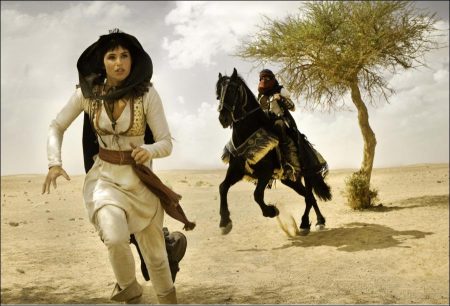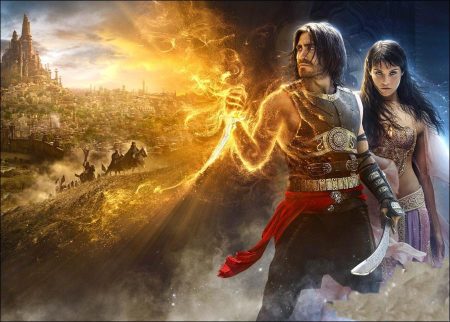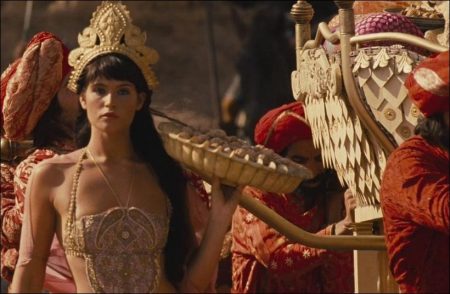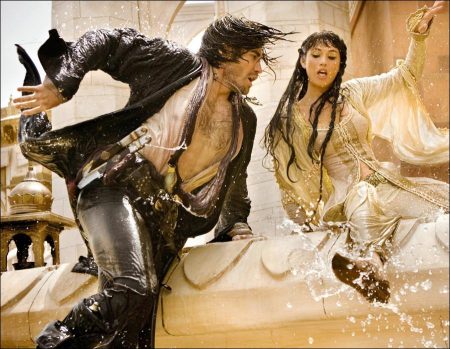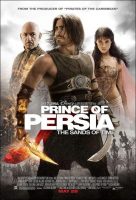Taglines: Defy the Future.
In Persia, in the Royal City of Nasaf, the fair King Sharaman rules the empire with his brother Nizan. Sharaman has two sons, but adopts the orphan Dastan that becomes part of his family. Years later, the Holy City of Alamut ruled by Princess Tamina is under siege of the troops led by Tus, Garsiv and Dastan, after their uncle Nizan had intercepted a spy carrying weapons for Alamut.
Dastan invades the city with his men to avoid a massacre and the Persian army conquers the city. Dastan gets a dagger from an enemy and King Sharaman comes to Almut very upset with the invasion of the holy city. Then he arranges the marriage of Dastan with Princess Tamina. When Dastan gives a holy cloak delivered by Tus to his father, the mantle is poisoned and kills Sharaman. Dastan is accused of betrayal but he escapes with Princess Ttamina. Sooner he finds that the dagger is a powerful device to travel and change time and that Tus is not the traitor and he engages with Tamina in a quest for justice.
Movie based on the video game – set in medieval Persia, Earth’s mightiest and most mysterious kingdom, where a king and his son defeat the powerful Maharajah and kidnap his daughter, looting his palace of priceless treasure, including an extravagant hourglass, and a mysterious dagger.
From the team that brought the “Pirates of the Caribbean” trilogy to the big screen, Walt Disney Pictures and Jerry Bruckheimer Films present “Prince of Persia: The Sands of Time,” an epic action-adventure set in the mystical lands of Persia. A rogue prince (Jake Gyllenhaal) reluctantly joins forces with a mysterious princess (Gemma Arterton) and together, they race against dark forces to safeguard an ancient dagger capable of releasing the Sands of Time—a gift from the gods that can reverse time and allow its possessor to rule the world.
Directed by Mike Newell (“Harry Potter and the Goblet of Fire”) with a cast that includes Sir Ben Kingsley and Alfred Molina, and a screenplay by Boaz Yakin and Doug Miro & Carlo Bernard from a screen story by Jordan Mechner, “Prince of Persia: The Sands of Time” hits theatres Memorial Day weekend 2010.
Prince of Persia: The Sands of Time is an adventure action fantasy film directed by Mike Newell. The film was written by Jordan Mechner, Boaz Yakin, Doug Miro, and Carlo Bernard, produced by Jerry Bruckheimer, and released by Walt Disney Pictures. The film stars Jake Gyllenhaal as Prince Dastan, Gemma Arterton as Princess Tamina, Ben Kingsley as Nizam, and Alfred Molina as Sheik Amar.
The film has the same title as the video game Prince of Persia: The Sands of Time, and is primarily based on it. Elements from Warrior Within and The Two Thrones, the two other titles from the Sands of Time trilogy of the Prince of Persia video game franchise, are also incorporated. The film received mixed reviews from critics and failed at the domestic box office, but became the highest-grossing film based on a video game.
About the Story
Filmmakers Take Jordan Mechner’s Exotic World to New Heights
“We love bringing audiences into new worlds they haven’t yet explored,” says producer Jerry Bruckheimer, “and ancient Persia is one of the most wonderful of them all. It has such a rich heritage of imagination and fantasy, and we’ve tried to honour that in `Prince of Persia: The Sands of Time.’ We tackle epic films, from `Armageddon’ to `Pirates of the Caribbean,’ and `Prince of Persia: The Sands of Time’ falls right in line with those kinds of movies. It’s got enormous imagination, enormous scope and phenomenal action.”
Jordan Mechner created his seminal “Prince of Persia” video game in 1989. “I was looking for a universe that hadn’t yet been done in video games,” says Mechner. “The early days of video games were like the early days of cinema. We looked to previously established genres, like sword-and-sorcery and science fiction, to find things that would work in this new medium.”
Adds director Mike Newell: “I love the idea of it being a living myth that you are watching. This is a story that’s absolutely real and extraordinary – a non-rational, non-physical universe as we now understand it. These things happen in this film.”
It wasn’t Dastan’s birthright to become a prince – it was his destiny. As a boy in 6th century Persia – one of the greatest empires the world has ever known – young Dastan is a street urchin, parentless and penniless. Threatened with severe punishment by a Persian Army captain after defending a youngster caught stealing an apple, Dastan is first spared, and then adopted, by the noble King Sharaman, who detects a touch of greatness in Dastan. Raised alongside Sharaman’s sons Tus (Richard Coyle) and Garsiv (Toby Kebbell), and taught the ways of wisdom and nobility by his adoptive father and beloved uncle, Nizam (Kingsley), Dastan retains his rough edges while growing into a strong young warrior.
“What appealed to me about the story is the notion that everybody has great potential,” says Kingsley. “And this is where I thought it would be a very affirming film, particularly for young people – to realize that whilst you might be a child of the streets, it doesn’t mean that your potential is any less than that of a child from the palace. Our film is an examination of the potential of a child coming into adulthood, and the choices he has.”
Dastan, driven to prove his worth, leads the attack on Alamut, a peaceful holy city which is reported by spies to be hording weapons that are supplied to Persia’s enemies. But in fact, Alamut holds a much deeper and greater treasure – the legendary Sands of Time, which gives mortals the ability to turn back time. Dastan comes into possession of an ancient glass-handled dagger, the key to accessing the Sands of Time, but King Sharaman is assassinated and Dastan is accused of the crime. Now on the run and desperate to clear his name, Dastan finds himself in an uneasy alliance with Tamina, a feisty young Alamut princess whose family has guarded the Sands of Time for centuries, and who will do whatever it takes to protect it.
Dastan and Tamina, who are like oil and water from the start, are challenged to survive the unforgiving desert and some even more unforgiving enemies – from the wily Sheikh Amar (Molina) and master African knife thrower Seso (Steve Toussaint) to the deadly attempts of the Hassansins – each one trained to kill with their own lethal techniques. It will take all of Dastan’s bravery and fighting skills, as well as Tamina’s cunning, in order to uncover the one truly responsible for the king’s death, and for him to discover the nobility that truly lies within.
According to Gyllenhaal, the filmmakers had an interesting perspective about the film’s fantasy backdrop. “It was Mike Newell and Jerry Bruckheimer’s initial and brilliant idea that this film be based in reality. Mike said, `I want this movie to be based in the mentality of sixth-century Persia, where they believed in fantasy becoming reality, that you could find a dagger that could turn back time and have no doubt in the possibility of that happening because that’s what they would have believed back then.’”
At a time when European civilization was but a dim gleam on humanity’s horizon, mighty Persia was creating great cities and buildings throughout its vast and mighty empire: Persepolis, Baghdad, Susa, Pasargadae, Arg-é Bam, Isfahan. The Persian Empire at its height stretched from the Euphrates in the west to the Indus River in the east, and from the Caucasus, Caspian, and Aral seas in the north to the Persian Gulf and the Gulf of Oman in the south. In addition to country-regionIran itself, the empire included what are now the modern nations of Azerbaijan, Afghanistan, Pakistan, Turkmenistan, Tajikistan, Uzbekistan and the eastern parts of Turkey and Iraq and their surrounding regions.
Two great works of Persian literature greatly influenced Mechner: the Shahnameh, a massive work written by the great poet Ferdowsi in approximately 1000 AD and considered to be the national epic of country-regionplaceIran, and One Thousand and One Nights, a collection of stories dating back to the ninth century that incorporated ancient Persian, Middle Eastern and Indian folktales and legends. Mechner recognized that he could build an alternative world based upon the historical realities of ancient Persia, creating new mythologies about a culture that had created so many of its own fantasies for thousands of years.
Mechner created a protagonist who defied gravity with his acrobatic acumen, yet remained governed by the laws of physics and human capability. “With `Prince of Persia,’ I wanted to create a character that felt like flesh and blood – like if he missed the jump, it would really hurt,” he says.
Mechner was not only creating a character who leapt from one precipice to another; the young video-game genius was also taking a giant leap himself, seeking new technologies to bring his world of “Prince of Persia” to life as fully as possible. “The world of the `Prince of Persia’ video game was fascinating,” says executive producer Mike Stenson. “It had a wonderful fantasy aspect about it, and the Sands of Time element introduced in the 2003 game was perfect for the big screen. We felt that we should have elements of the game, but, just as we did with `Pirates of the Caribbean,’ develop our own story, taking off from what was given us. But we think we’re being true to Jordan Mechner’s vision of the game.”
Newell was, of course, tapped to direct the big screen’s “Prince of Persia: The Sands of Time.” Says Bruckheimer, “Mike can do just about any kind of movie, from `Four Weddings and a Funeral,’ which is a dramatic comedy, to `Donnie Brasco,’ a hard-edged, gritty street movie. And then he goes and does `Harry Potter and the Goblet of Fire,’ which had just the right blend of adventure and mystical fantasy that we were looking for. Mike has a really wonderful palette that he paints from, and that’s very important to us. We want an entertaining film that appeals to a broad audience, but also something special, that concentrates on character and story.”
“The more exquisite, the more dark, the more agonized, the more true to our fallible human natures a film can be – that’s a good Brit picture,” says Newell. “But lately, I’ve been really interested in great, big entertainment – `Prince of Persia: The Sands of Time’ is exactly that – great, big entertainment – and I’m very pleased to have it.”
Prince of Persia: The Sands of Time (2010)
Directed by: Mike Newell
Starring: Jake Gyllenhaal, Gemma Arterton, Alfred Molina, Ben Kingsley, Toby Kebbell, Richard Coyle, Thomas DuPont, Ronald Pickup, Reece Ritchie, Gísli Örn Garðarsson, Claudio Pacifico
Screenplay by: Doug Miro, Carlo Bernard, Jordan Mechner
Production Design by: Wolf Kroeger
Cinematography by: John Seale
Film Editing by: Mick Audsley, Michael Kahn, Martin Walsh
Costume Design by: Penny Rose, Louis Joon
Set Decoration by: Elli Griff
Art Direction by: Maria-Teresa Barbasso, Robert Cowper, Marc Homes, Leslie Tomkins, David Doran, Stuart Rose, Alex Santucci, Marco Trentini
Music by: Harry Gregson-Williams
MPAA Rating: PG-13 for intense sequences of violence and action.
Distributed by: Buena Vista Pictures
Release Date: May 28, 2010

